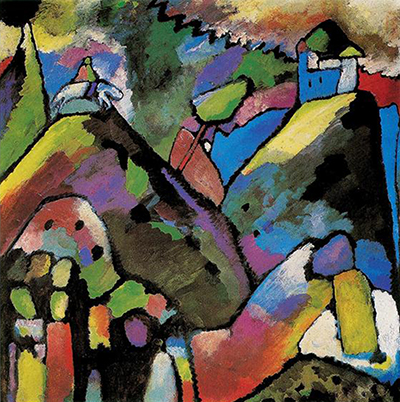This colourful piece from 1910 is an early abstract painting from Russian painter Wassily Kandinsky. It can now be found at the Staatsgalerie Stuttgart in Germany.
We find a group of figures in the bottom left corner of this composition, stood in front of a series of tall mountains. At the very top is a pretty castle which was influenced by Kandinsky's Russian roots. There is also a horse and rider across to the left. At the very top is a jagged set of what appear to be steps, making their way downwards, falling just behind the castle. The colour scheme is bright in the extreme, though there is some use of black tones in order to balance most of this out.
Kandinsky's improvisations were a series of pieces where he attempted to connect with the inner workings of his mind and experiment with the output. He was someone who was interested in the theory of art and would later release his own publications based on different elements of this. During this part of his career he would seek to alter the balance between depicting reality and the subconscious, prefering the second of those, but also trying out different balances between the two. This was significant during the early 20th century, when a number of painters would pick up on the teachings of Freud and use it as inspiration for a new type of art, just as he had encouraged a new way of thinking about the activities of the brain.
When one interacts with their inner mind, chaos normally occurs on the canvas! Many of the standard disciplines of painting are lost, in terms of structure, and a certain element of randomness occurs. It is difficult for anyone to be sure about how much they are connected with different parts of their brain over other parts, but the experiments are still entirely valid and can be considered part of a wider movement towards ultimate self-expression. We are also left here with two considerations, one of the aesthetic beauty of each iteration in the series, and secondly the overall importance of what the artist was trying to achieve here.




